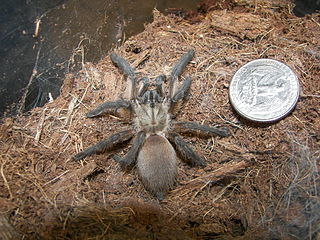
Hyllus is a genus of the spider family Salticidae. Most species occur in Africa and Madagascar, with many in Australasia and north to India. H. insularis is found in Greece and Iran, but it is considered misplaced in this genus, and is now Evarcha insularis.
Pochyta is a genus of African jumping spiders that was first described by Eugène Louis Simon in 1901.

Nemesiidae, also known as funnel-web trapdoor spiders, is a family of mygalomorph spiders first described by Eugène Simon in 1889, and raised to family status in 1985. Before becoming its own family, it was considered part of "Dipluridae".

Hersilia, also known as long-spinnered bark spiders and two-tailed spiders, is a genus of tree trunk spiders that was first described by Jean Victoire Audouin in 1826. Their nicknames are a reference to their greatly enlarged spinnerets.

Sason is a genus of bark-dwelling brushed trapdoor spiders first described by Eugène Simon in 1887. It is distributed from the Seychelles through India to northern Australia. The closest related genus seems to be the monotypic Paracenobiopelma.

Sason robustum is a species of barychelid trapdoor spiders. It is only found in southern India, Sri Lanka and the Seychelles.

Porrhothele antipodiana, the black tunnelweb spider, is a spider found throughout much of New Zealand and the Chatham Islands in bush and gardens and is one of New Zealand's most researched spiders. It is related to tarantulas, and is a harmless relative of the venomous Australian funnel-web spider.

Phormictopus is a genus of spiders in the family Theraphosidae (tarantulas) that occurs in the West Indies, mainly Cuba and Hispaniola, with three species probably misplaced in this genus found in Brazil and Argentina.

Porrhothele is a genus of mygalomorph spiders endemic to New Zealand. They are the only members of the family Porrhothelidae. They were first described by Eugène Louis Simon in 1892. Originally placed with the curtain web spiders, it was moved to the Hexathelidae in 1980, they were placed in their own family in 2018.

Phoneyusa is a genus of spiders belonging to the family Theraphosidae (tarantulas).

Cyriopagopus is a genus of southeast Asian tarantulas found from Myanmar to the Philippines. As of March 2017, the genus includes species formerly placed in Haplopelma. It was first described by Eugène Louis Simon in 1887.

Copa is a genus of corinnid sac spiders first described by Eugène Simon in 1886.

The Eumenophorinae are a subfamily of tarantula spiders. They are known from genera distributed across Africa, southwestern countries in Saudi Arabia, and Madagascar and the associated islands.
Tigidia is a genus of brushed trapdoor spiders first described by Eugène Simon in 1892.
Carteronius is a genus of African corinnid sac spiders first described by Eugène Simon in 1896.

Fufius is a genus of Central and South American wafer trapdoor spiders that was first described by Eugène Simon in 1888. Originally placed with the curtain web spiders, it was moved to the Cyrtaucheniidae in 1941.
Homostola is a genus of African mygalomorph spiders in the family Bemmeridae. It was first described by Eugène Louis Simon in 1892. Originally placed with the Ctenizidae, it was transferred to the wafer trapdoor spiders in 1985, and to the Bemmeridae in 2020. It is a senior synonym of Stictogaster and Paromostola.
Remmius is a genus of African huntsman spiders that was first described by Eugène Louis Simon in 1897.
Tanybria is a genus of leaf beetles in the subfamily Eumolpinae. It is distributed in Africa.











